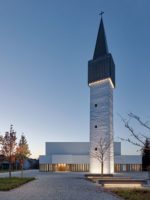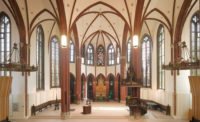St. Bartholom'us Church
Heaven and Earth: A firm turns a 1960s church into a place of final repose and, once again, worship.


















Architects & Firms
Cologne, Germany
Dwindling congregations and shifting demographics have led to church closings throughout Germany, as elsewhere, in recent years. Yet some, such as Saint Bartholom'us, a Roman Catholic church in Cologne, are deconsecrated and repurposed as columbaria housing the ashes of the deceased. After it shut down in 2006, the congregation wanted Saint Bartholom'us's building to retain a sacred space to hold funeral services in addition to a de-sanctified area to house the urns. Because Catholic doctrine permits burial within church walls only for popes, emperors, and archbishops, and it prohibits the celebration of the Mass in cemeteries, the task required the interior to be divided into two spaces, one sacred and the other secular.
To define the sanctified area, he inserted into the church's center an architectural bronze mesh enclosure, measuring 23 by 33 feet in plan. The mesh stretches between a track in the floor and a rectangular frame located 33 feet above. Steel bars secure the frame to the church's concrete ceiling beams. Adjustable LED luminaires, which are attached to the frame, shine on the mesh, wrapping the sacred area in an ethereal glow. Depending on their angle, the LEDs cause the mesh to appear either transparent or translucent. Furnishings include both new pieces (the bronze and steel pulpit and urn stand, the concrete altar) and recycled ones (the church's original pine benches).
Six-foot-high black-steel cabinets, which house the urns, form 10 alcoves around the sanctified area. The cabinets contain 1,600 niches for a total of 2,400 urns (800 in single and 1,600 in double compartments). After an urn is installed, a bronze plaque with a shelf for commemorative items seals the niche; a single light bulb, suspended from the ceiling, illuminates each alcove.
Other alterations draw attention to the church's religious art. Expressively carved figures, depicting the Stations of the Cross (1988) by sculptor Ludek Tich', formerly located along the interior walls, now adorn the ends of the urn cabinets. Red spotlights accentuate the concrete ceiling and complement Giselbert H'ke's stained-glass windows (1978) depicting the Resurrection.
To reduce costs, heating was eliminated, except in the vestibule on the west facade, which is newly equipped with offices and restrooms. The highly emotive quality of this church-cum-columbarium notwithstanding, a prolonged visit on a recent December midday left one with cold feet and a chill. Temperature aside, the dusky space feels welcoming and surprisingly uplifting. The urn cabinets seem to disappear into the shadows, in contrast to the sacred area's radiance, which beckons, like a clearing in a forest. Small, gleaming accents throughout'the suspended light bulbs in each alcove, the glinting bronze seals adorning the niches holding the urns'inject visual warmth and a sense of enchantment into this sober setting.
The dual areas'one sanctified, the other merely solemn'were intended to maintain the church's relevance and to ensure that a respectful consideration of death plays a role in the everyday life of this urban neighborhood. This strategy is succeeding: 'It is surprising,' notes columbarium administrator David Blumann, 'how many people have come by just to take a look.'
PeopleOwner: Katholische Kirchengemeinde Zu den Heiligen Rochus, Dreikönigen und Bartholomäus
Architect:
Personnel in architect's firm who should receive special credit:
Photographer(s): CAD system, project management, or other software used: Nemetschek, Allplan 2014 Size: 6,450 square feet Construction Cost: $1.2 million Completion Date: January 2014 |
Products
Structural system
Exterior cladding
Windows
Glazing
Doors Wood doors: side entrance door in oakwood
Interior finishes Ground floor: screed, sharpened Mausoleum: steel construction with burnished brass plate exterior. 890 double and 700 individual graves with a total of 2,480 urn chambers: Schlosserei und Metallbau Venino
Furnishings Chairs: wooden benches
Other furniture: Ambon, Paschal candle holder, urn pedestal: Steel structures with adorned burnished and plank brass plate Way of the Cross: expressive wood reliefs designed by the artist Ludek Tichy
Lighting
Dimming System or other lighting controls: The top edge of the approximately 7-metre high net will be equipped with LED lights arranged and installed on both sides with an angle of approximately 3 degrees allowing the entire length of the net to be evenly illuminated. Each urn cabinet within the bronze urn complex will be accentuated by a pendant lamp. The whole space, inspired by the window design, will be dimly lit and, supported by candle light, give the sepulchre the desired contemplative mood. |




